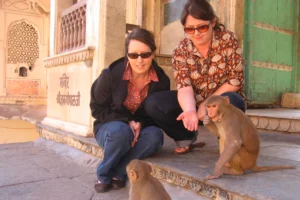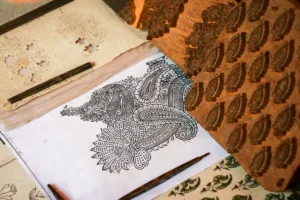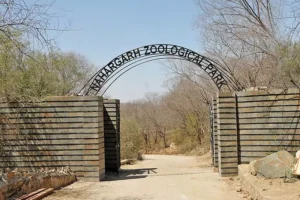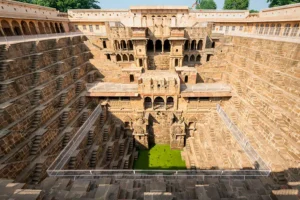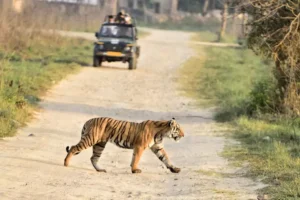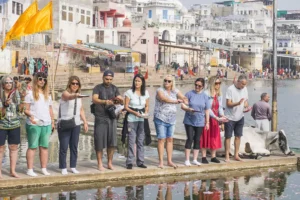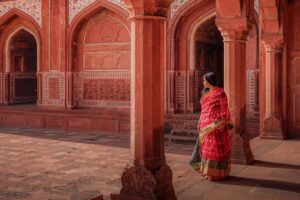Gaitore Ki Chhatriyan Jaipur – A Timeless Glimpse into Royal Heritage
Gaitore Ki Chhatriyan, also known as the Gatore Cenotaphs, is a historic site situated in the lush valleys of Nahargarh and near the Garh Ganesh Temple in Jaipur. This site serves as the royal cremation grounds for Jaipur's esteemed rulers, embodying the city's rich royal legacy. The cenotaphs are notable for their exquisite Rajput architecture, which features intricate carvings and ornate domes that celebrate the craftsmanship of the era.
The complex is a serene place, offering visitors a glimpse into the cultural heritage of Rajasthan. Each cenotaph is dedicated to a specific ruler, with memorials that narrate the tales of Jaipur's royal past. The setting, surrounded by picturesque hills and historical fortifications, enhances the site's tranquility and beauty, making it a perfect spot for reflection and exploration.
As you wander through the Gaitore Ki Chhatriyan, you'll encounter the grand cenotaph of Sawai Jai Singh II, renowned for its stunning white marble and detailed artistry. This site is not just a memorial but a testament to the grandeur of Jaipur's history, inviting visitors to appreciate its architectural beauty and historical significance.
Location Details
Gaitore Ki Chhatriyan, Krishna Nagar, Brahampuri, Jaipur, Rajasthan 302002, India
Architectural Marvels in Rajput Style:
The Gaitore Ki Chhatriyan, a stunning representation of Rajput architecture, beautifully integrates Rajput and Mughal design elements. This architectural site is celebrated for its intricate carvings that embellish the pillars and dome roofs, exemplifying the exquisite craftsmanship of the artisans from that era. The delicate artistry not only reflects the opulence of Jaipur's royal history but also showcases a rich blend of cultural influences.
The cenotaphs are primarily constructed from marble and display a variety of artistic motifs, including floral patterns and depictions of deities, which add to their grandeur. Each chhatri serves as a memorial for Jaipur's rulers, emphasizing their legacy and the respect accorded to them in death. The harmonious design and elaborate details invite visitors to appreciate the historical significance and aesthetic beauty of this remarkable site.
For more detailed information about the architectural features and historical context of Gaitore Ki Chhatriyan, you can explore resources such as Rajasthan Tourism and other travel blogs that delve into Jaipur's cultural heritage.
A Chronicle of Royal Memorials:
The Gaitore Ki Chhatriyan serves as a significant testament to Jaipur's royal heritage, divided into three distinct sections that chronicle the legacies of its rulers. Each chhatri (dome) commemorates prominent figures, from Sawai Jai Singh II to Man Singh II, and embodies the architectural brilliance and artistry of the time. The intricate stone carvings, circular staircases, and decorative pillars narrate stories of bygone eras, evoking a deep sense of history and culture.
Visitors can appreciate not only the artistic craftsmanship but also the historical significance of each memorial. The site creates a breathtaking panorama that captures the essence of Jaipur's royal lineage, showcasing the reverence and honor bestowed upon these rulers even after their demise.
For further insights into the royal memorials and their historical context, you may find more information at resources dedicated to Rajasthan's cultural heritage.
Tranquil Oasis Amid Nahargarh Valley:
Gaitore Ki Chhatriyan is nestled in the serene valleys of Nahargarh, flanked by the majestic fort walls and offering stunning views of the vibrant city of Jaipur. This tranquil setting was deliberately chosen by Sawai Jai Singh II, reflecting his desire to create a peaceful resting place for the revered rulers of Jaipur. The site’s unique ambiance harmonizes the natural beauty of the surrounding landscape with the historical significance of the memorials, making it a perfect oasis for visitors seeking both serenity and insight into the region’s royal legacy.
The juxtaposition of the tranquil cenotaphs against the bustling backdrop of Jaipur further enhances its charm, inviting visitors to explore the rich cultural heritage while enjoying the calm surroundings. This serene environment allows for contemplation and appreciation of the architectural grandeur, underscoring the thoughtful design and placement of these memorials.
For a deeper understanding of the tranquility and historical significance of Gaitore Ki Chhatriyan, you can explore more about it through resources focusing on Rajasthan's heritage.
Cenotaph of Sawai Jai Singh II:
The cenotaph dedicated to Sawai Jai Singh II is the most impressive of the memorials at Gaitore Ki Chhatriyan. This stunning structure is crafted from pristine white marble and serves as a remarkable tribute to Jaipur's most distinguished ruler. The cenotaph is adorned with elaborate carvings that depict various figures, including Hindu deities, musicians, and maids, showcasing the intricate artistry that characterizes Rajput architecture.
Notably, the dome of the cenotaph is supported by 20 elegantly carved pillars, each contributing to the overall grandeur of the monument. This architectural masterpiece not only reflects the opulence of its time but also symbolizes the reverence held for Sawai Jai Singh II in Jaipur's history. Interestingly, a replica of this cenotaph is housed in the prestigious Kensington Museum in London, further emphasizing its historical significance and cultural valueation on the Gaitore Ki Chhatriyan and its remarkable architecture, you can explore resources dedicated to Jaipur’s rich heritage and royal history.
A Place of Royal Honor:
The cenotaphs at Gaitore Ki Chhatriyan are not only architectural marvels but also significant sites of royal honor and remembrance. These structures were built to commemorate the deceased kings of Jaipur, reflecting the deep respect and dignity with which they were cremated. The term "Gaitore" translates to "resting place of the deceased," emphasizing the sacred nature of this site.
Each cenotaph serves as a tribute to the legacy of the rulers, showcasing the artistry and craftsmanship of the period. The intricate designs and carefully planned layout signify the importance of honoring these kings, whose contributions shaped the history and culture of Jaipur. The serene setting amidst the Nahargarh hills further enhances the solemnity and respect associated with these memorials.
For a deeper exploration of the significance of Gaitore Ki Chhatriyan and its historical context, you can find additional information on various travel and heritage websites that discuss Jaipur's royal heritage and architectural landmarks.
Timings and Entry Fees:
Opening its gates at 9:30 AM and closing at 5:00 PM, with the ticket window closing by 4:30 PM, Gaitore Ki Chhatriyan welcomes visitors to immerse themselves in its regal ambiance. The entry fee varies for Indian and foreign tourists, with additional concessions for children, students, senior citizens, defense personnel, and specially-abled individuals.
| Visitor Type | Entry Fee |
|---|---|
| Indian Adults | ₹40 |
| Indian Children (5-12 years) | ₹20 |
| Foreign Adults | ₹100 |
| Foreign Children (5-12 years) | ₹50 |
| Children below 5 years | Free |
| Senior Citizens | ₹30 |
| Defense Personnel | ₹30 |
| Specially Abled | ₹30 |
Note – Entry for children below 5 years is Free, and the entry fees include Camera and small video camera
Surrounding Attractions:
To enhance your exploration of Gaitore Ki Chhatriyan, consider visiting the historic Garh Ganesh Temple nearby. This temple is dedicated to Lord Ganesha and offers a peaceful atmosphere along with stunning architecture.
You can also explore several other nearby attractions that enrich your experience of Jaipur's heritage:
-
Nahargarh Fort: Located on the Aravalli hills, this fort provides breathtaking views of the city and offers insight into Jaipur's history.
-
Hawa Mahal: Known as the "Palace of Winds," this iconic structure features an intricate façade and is a must-visit for its unique architecture.
-
City Palace: A magnificent complex that showcases a blend of Rajput and Mughal styles, the City Palace houses museums with royal artifacts and gives a glimpse into Jaipur's royal past.
-
Kalki Temple: This temple is dedicated to Lord Kalki, an incarnation of Lord Vishnu, and provides a serene environment for visitors seeking tranquility.
-
Isarlat: Also known as Isar Lat, this historic tower is lesser-known but offers architectural beauty and a glimpse into Jaipur's past.
Visiting these attractions will provide you with a rich and diverse experience of Jaipur's culture, architecture, and spirituality. Enjoy your exploration!
Getting There:
Reaching Gaitore Ki Chhatriyan is quite convenient, as it is well-connected by various transportation options such as taxis, cabs, and auto-rickshaws. However, there isn't a direct bus service to the site. Visitors can be dropped off at Brahmapuri, which is nearby, and from there, it's just a short walk to the cenotaphs.
For those looking for more flexibility during their exploration of Jaipur, renting a bike is an excellent option. This allows you to navigate the city at your own pace and enjoy the scenic routes leading to Gaitore Ki Chhatriyan and other attractions.
For more detailed transportation options and tips, you can refer to local travel guides or resources that cover Jaipur's transportation system extensively.
Nearest Transportation Hubs:
- Sindhi Camp Bus Stand: 5.8 Kms
- Jaipur Railway Station: 8.3 Kms
- Jaipur International Airport: 14.8 Kms
As you explore the fascinating history and regal allure of Gaitore Ki Chhatriyan, don’t forget to discover Jaipur’s wide array of tourist attractions. This city is a treasure trove of cultural and historical sites, each offering its unique charm and story.
If you have tips or experiences to share about your visit, feel free to leave your insights in the comments. For more travel inspiration and updates, follow us on Facebook and Instagram!



